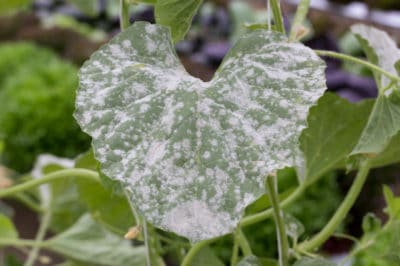Identifying Powdery Mildew
Of all the many pests and diseases that attack squash plants, powdery mildew is the only one that can cause whitish-gray leaves. Powdery mildew looks like flour dust when on the leaves. The fungus appears on both sides of the leaves and the stems: fruit is not usually directly affected. Here are other ways powdery mildew can affect squash plants:
- Leaves may gradually turn completely yellow, die, and fall off.
- Leaves may twist.
- Leaves may buckle.
- May shorten production time.
- May reduce fruit yields.
- May produce fruit with less flavor.
The Cause of Powdery Mildew
Powdery mildew from live host plants overwinters in the soil. When the conditions are right, special resting spores of powdery mildew start reproducing. The spores are spread by wind. The fungus grows best in high humidity, dry conditions, shady areas, and moderate temperatures of 60°F to 80°F(16°C to 27°C). Temperatures over 90°F(32°C) and direct sunlight are enemies of powdery mildew.
Proactive Steps in Preventing Powdery Mildew
Controlling the conditions of the plant environment may reduce powdery mildew growth. Here are some suggestions that may prevent the fungus from growing:
- Space squash plants about three feet apart.
- Plant in area that receives six or more hours of direct sunlight per day.
- Plant only healthy plants.
- Use powdery mildew resistant varieties of seed and plants.
- Avoid using excess fertilizer.
Controlling or Killing Powdery Mildew
You may follow these suggestions and still be plagued with powdery mildew. Don’t be too dismayed. This fungus is more nasty-looking than dangerous. There are safe choices for reducing or killing it.
Organic Milk Fungicide
Organic milk that has not been pasteurized can control the severity of powdery mildew. To make this organic fungicide, mix one part organic milk with nine parts water. Pour mixture into a garden sprayer. Once a week spray the entire plant including the underside of leaves.
Homemade Baking Soda Spray
Baking soda combined with a dormant oil and liquid soap is effective against powdery mildew if it is applied prior to or early in an outbreak of fungus. Combine these ingredients to make your mixture: one tablespoon of baking soda, one teaspoon of dormant oil, one teaspoon of insecticidal or liquid soap (not detergent), and one gallon of water. Apply weekly.
Potassium Bicarbonate
Scientific studies have proven that potassium bicarbonate is an effective substance in killing powdery mildew. Here are the ingredients to make this effective fungicide: three tablespoons of potassium bicarbonate, three tablespoons of vegetable oil, a half teaspoon of soap, one gallon of water.
